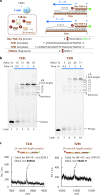Rapid Chemical Ligation of DNA and Acyclic Threoninol Nucleic Acid (a TNA) for Effective Nonenzymatic Primer Extension
- PMID: 37466125
- PMCID: PMC10436273
- DOI: 10.1021/jacs.3c04979
Rapid Chemical Ligation of DNA and Acyclic Threoninol Nucleic Acid (a TNA) for Effective Nonenzymatic Primer Extension
Abstract
Previously, nonenzymatic primer extension reaction of acyclic l-threoninol nucleic acid (L-aTNA) was achieved in the presence of N-cyanoimidazole (CNIm) and Mn2+; however, the reaction conditions were not optimized and a mechanistic insight was not sufficient. Herein, we report investigation of the kinetics and reaction mechanism of the chemical ligation of L-aTNA to L-aTNA and of DNA to DNA. We found that Cd2+, Ni2+, and Co2+ accelerated ligation of both L-aTNA and DNA and that the rate-determining step was activation of the phosphate group. The activation was enhanced by duplex formation between a phosphorylated L-aTNA fragment and template, resulting in unexpectedly more effective L-aTNA ligation than DNA ligation. Under optimized conditions, an 8-mer L-aTNA primer could be elongated by ligation to L-aTNA trimers to produce a 29-mer full-length oligomer with 60% yield within 2 h at 4 °C. This highly effective chemical ligation system will allow construction of artificial genomes, robust DNA nanostructures, and xeno nucleic acids for use in selection methods. Our findings also shed light on the possible pre-RNA world.
Conflict of interest statement
The authors declare no competing financial interest.
Figures





Similar articles
-
Chirality-Promoted Chemical Ligation and Reverse Transcription of Acyclic Threoninol Nucleic Acid.J Am Chem Soc. 2025 May 28;147(21):17967-17974. doi: 10.1021/jacs.5c03128. Epub 2025 Apr 17. J Am Chem Soc. 2025. PMID: 40245353 Free PMC article.
-
Nonenzymatic polymerase-like template-directed synthesis of acyclic L-threoninol nucleic acid.Nat Commun. 2021 Feb 5;12(1):804. doi: 10.1038/s41467-021-21128-0. Nat Commun. 2021. PMID: 33547322 Free PMC article.
-
Highly Effective Chemical Ligation of DNA and l-aTNA.Curr Protoc. 2025 May;5(5):e70140. doi: 10.1002/cpz1.70140. Curr Protoc. 2025. PMID: 40331446
-
Xeno nucleic acids (XNAs) having non-ribose scaffolds with unique supramolecular properties.Chem Commun (Camb). 2022 Mar 24;58(25):3993-4004. doi: 10.1039/d1cc05868a. Chem Commun (Camb). 2022. PMID: 35107445 Review.
-
Design and Hybridization Properties of Acyclic Xeno Nucleic Acid Oligomers.Chembiochem. 2021 Aug 3;22(15):2507-2515. doi: 10.1002/cbic.202100184. Epub 2021 Jun 2. Chembiochem. 2021. PMID: 33998765 Review.
Cited by
-
Sequencing of d/l-DNA and XNA by Templated-Synthesis.J Am Chem Soc. 2025 Feb 19;147(7):6288-6296. doi: 10.1021/jacs.5c00708. Epub 2025 Feb 10. J Am Chem Soc. 2025. PMID: 39930695 Free PMC article.
-
Chirality-Promoted Chemical Ligation and Reverse Transcription of Acyclic Threoninol Nucleic Acid.J Am Chem Soc. 2025 May 28;147(21):17967-17974. doi: 10.1021/jacs.5c03128. Epub 2025 Apr 17. J Am Chem Soc. 2025. PMID: 40245353 Free PMC article.
-
Manganese(II) promotes prebiotically plausible non-enzymatic RNA ligation reactions.Chem Commun (Camb). 2024 Jun 20;60(51):6528-6531. doi: 10.1039/d4cc01086h. Chem Commun (Camb). 2024. PMID: 38836405 Free PMC article.
References
-
- Gilbert W. Origin of Life: The RNA World. Nature 1986, 319, 618–618. 10.1038/319618a0. - DOI
-
- Inoue T.; Orgel L. E. Substituent Control of the Poly(C)-Directed Oligomerization of Guanosine 5’-Phosphoroimidazolide. J. Am. Chem. Soc. 1981, 103, 7666–7667. 10.1021/ja00415a051. - DOI
- Tam C. P.; Zhou L.; Fahrenbach A. C.; Zhang W.; Walton T.; Szostak J. W. Synthesis of a Nonhydrolyzable Nucleotide Phosphoroimidazolide Analogue that Catalyzes Nonenzymatic RNA Primer Extension. J. Am. Chem. Soc. 2018, 140, 783–792. 10.1021/jacs.7b11623. - DOI - PMC - PubMed
Publication types
MeSH terms
Substances
LinkOut - more resources
Full Text Sources
Miscellaneous

